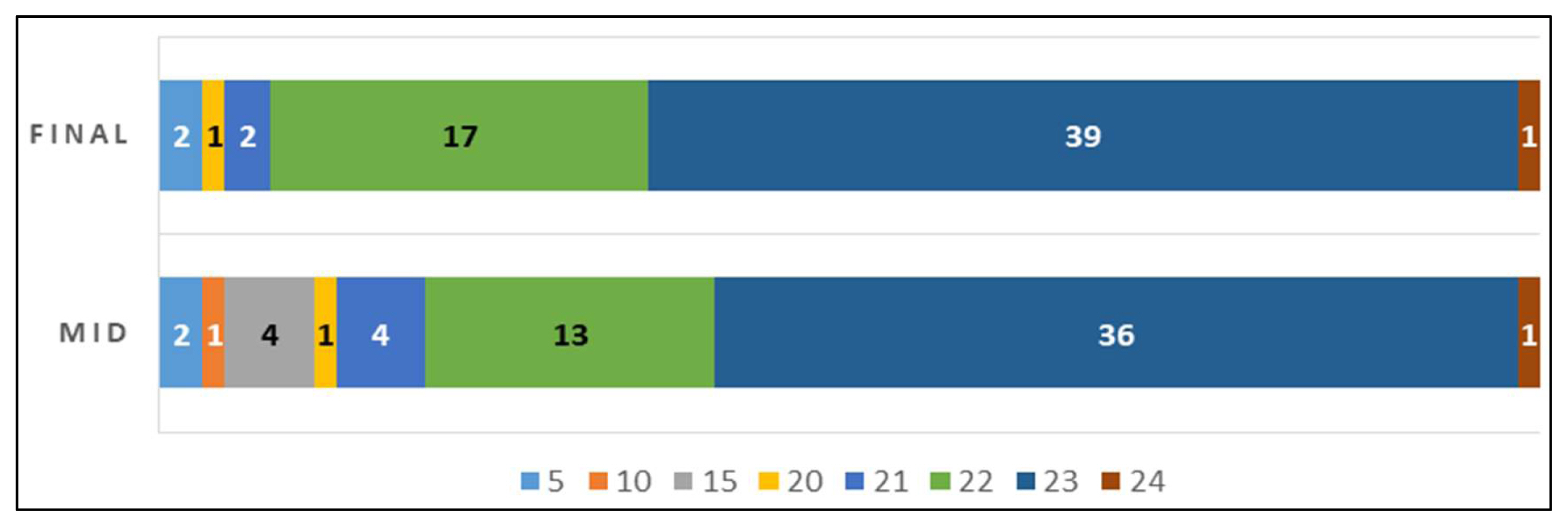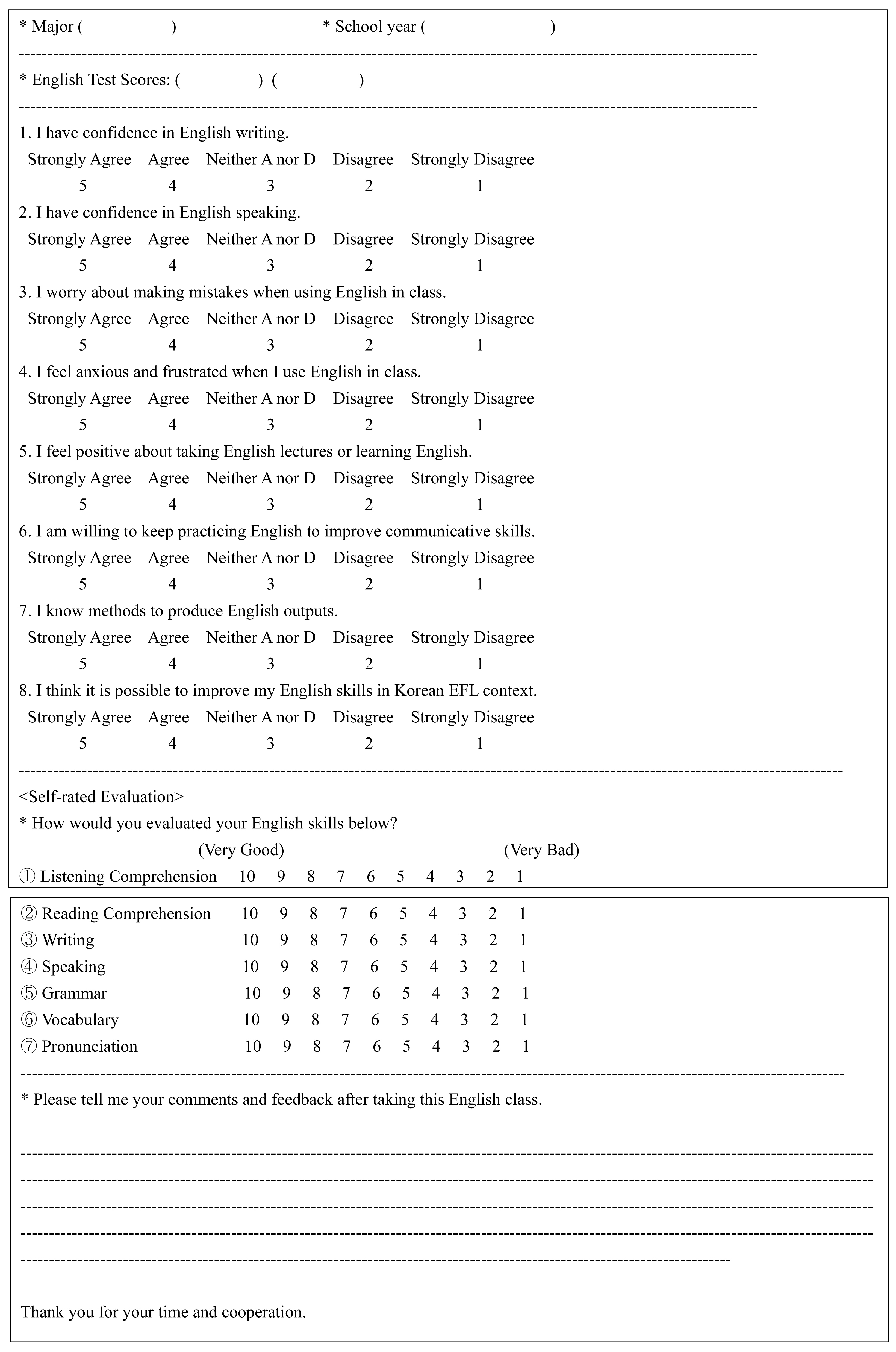Anderson, J., & Freiberg, H. (1995). Using self-assessment as a reflective tool to enhance the student teaching experience. Teacher Education Quarterly, 22(1), 77-91.
Borhany, M., Tahriri, A., & Tous, M. (2015). The impact of explicit/integrated instruction of listening comprehension strategies on EFL learnersŌĆÖ L2 listening comprehension and their overall strategy use. Journal of Applied Linguistics and Language Research, 2(8), 128-144.
Brown, B. (2012). Raising student awareness of pronunciation and exploring out-of-class approaches to pronunciation practice. Research Notes, 48, 18-23.
Bygate, M. (1987). Speaking. Oxford, England:Oxford University Press.
Bygate, M. (2001). Effects of task repetition on the structure and control of oral language. In M. Bygate & P. Skehan & M. Swain (Eds.),
Researching pedagogic tasks: Second language learning, teaching, and testing. pp 23-49. New York, NY:Pearson Education/Longman.

Celce-Murcia, M., Brinton, D., Goodwin, J., & Griner, B. (2010). Teaching pronunciation: A course book and reference guide (2nd ed). Cambridge, UK:Cambridge University Press.
Chong, C. M. (2019a). A comparative study of college studentsŌĆÖ reaction and attitude from English utterance output activities in Korean EFL contexts. Unpublished doctoral dissertation. Busan University of Foreign Studies: Busan.
Chong, C. M. (2019b). Exploring effective translation activities at college level with reference to reading aloud: A case study.
The Journal of Interpretation & Translation Education,
17(3), 131-151.
https://doi.org/10.23903/kaited.2019.17.3.007
.

Chong, C. M. (2021b). A study on performance diagnosis of college English courses in general education after core competency-based reform.
Korean Journal of General Education,
15(5), 247-282.
https://doi.org/10.46392/kjge.2021.15.5.247
.

C├│rdoba Z├║├▒iga, E. (2016). Implementing task-based language teaching to integrate language skills in an EFL program at a Colombian university.
PROFILE Issues in TeachersŌĆÖ Professional Development,
18(2), 13-27.
https://doi.org/10.15446/profile.v18n2.49754
.

Dlaska, A., & Krekeler, C. (2008). Self-assessment of pronunciation.
System,
36(4), 506-516.

Dochy, F., & McDowell, L. (1997). Introduction: Assessment as a tool for learning. Studies in Education Evaluation, 23(4), 279-298.
Gonz├Īlez-Betancor, S., Bol├Łvar-Cruz, A., & Verano-Tacoronte, D. (2019). Self-assessment accuracy in higher education: The influence of gender and performance of university students.
Active learning in higher education,
20(2), 101-114.
https://doi.org/10.1177/1469787417735604
.

Harmer, J. (2007). The practice of English language teaching (4th ed). Essex, England:Pearson Education.
Heo, S. (2017). Effects of reading aloud on listening comprehension of EFL learners. Korean Journal of General Education, 11(3), 377-399.
Hinkel, E. (2010). Integrating the four skills: Current and historical perspective. In R.D. Kaplan (Ed.), Oxford Handbook in Applied Linguistics. pp 110-126. Oxford, England:Oxford University Press.
Horwitz, E. K., Horwitz, M. B., & Cope, J. (1986). Foreign language classroom anxiety.
The Modern Language Journal,
70(2), 125-132.
https://doi.org/10.2307/327317
.

Hung, Y. (2019). Bridging assessment and achievement: Repeated practice of self-assessment in college English classes in Taiwan.
Assessment & Evaluation in Higher Education,
44(8), 1191-1208.
https://doi.org/10.1080/02602938.2019.1584783
.

Jaber, A. (2021). The effect of self-voice recording technique on oral performance of EFL learners in electronic learning.
Journal of Arts, Literature, Humanities and Social Sciences,
70, 249-260.
https://doi.org/10.33193/JALHSS.70.2021.555
.

Joe, J. (2003). Factors causing writing apprehension among ESL learners. STEM Journal, 3(2), 87-108.
Joh, J. (2002). Towards a more successful college English program: A survey of teachers and students. English Teaching, 57(2), 365-394.
Kara, S. (2013). Writing anxiety: A case study on studentsŌĆÖ reasons for anxiety in writing classes. Anadolu Journal of Educational Sciences International, 3(1), 103-111.
Kim, J. (2014). Effects of English writing as a pre-speaking activity on Korean EFL university learnerŌĆÖs speaking ability and anxiety. English Language & Literature Teaching, 20(1), 329-356.
Kim, N. (2018). Effects of reading aloud tasks through a mobile phone on EFL vocabulary and reading comprehension skills.
Multimedia-Assisted Language Learning,
21(1), 57-76.
https://doi.org/10.15702/mall.2018.21.1.57
.

Kim, Y., & Kim, J. (2005). Teaching Korean university writing class: Balancing the process and the genre approach. Asian EFL Journal, 7(2), 1-15.
Lee, E., & Yoon, H. (2010). The effects of writing as a pre-speaking activity on the college studentsŌĆÖ speaking performance.
English Language Teaching,
22(3), 143-166.

Levelt, W. (1989). Speaking: From intention to articulation. Cambridge, MA:MIT Press.
Munoz, A., & ├ülvarez, M. (2007). StudentsŌĆÖ objectivity and perception of self-assessment in an EFL classroom. The Journal of Asia TEFL, 4(2), 1-25.
Nation, P. (2013). What should every ESL teacher know?. Seoul:Compass.
Nodoushan, M. (2010). Reflective teaching in EFL classes: An overview.
I-ManagerŌĆÖs Journal on School Educational Technology,
6(3), 1-6.

Nunan, D. (2015). Teaching English to speakers of other languages: An introduction. New York, NY:Routledge.
Oxford, R. (2001). Integrated skills in the ESL/EFL classroom. ERIC Digest. Washington, DC:ERIC Clearinghouse on Language and Linguistics.
Park, J., & Park, C. (2018). Effects of learning environment differences (on and offline vs. offline) on intermediate level learnersŌĆÖ writing development.
STEM Journal,
19(2), 169-193.
https://doi.org/10.16875/stem.2018.19.2.169
.

Sadiku, L. (2015). The importance of four skills reading, speaking, writing, listening in a lesson hour.
European Journal of Language and Literature,
1(1), 29-31.
https://doi.org/10.26417/ejls.v1i1.p29-31
.

Scott, V. M. (1996). Rethinking foreign language writing. Boston, MA:Heinle & Heinle..
Senawati, J., Suwastini, N., Jayantini, G., Adnyani, N., & Artini, N. (2021). The benefits of reading aloud for children: A review in EFL context.
Indonesian Journal of English Education,
8(1), 73-100.
https://doi.org/10.15408/ijee
.

Song, J. (2006). Student-centered writing and speaking practice on the internet. English Language Teaching, 18(2), 179-202.
Swain, M., & Lapkin, S. (1995). Problems in output and the cognitive processes they generate: A step towards second language learning.
Applied Linguistics,
16(3), 371-391.

Trelease, J. (1995). The read-aloud handbook. Revised and updated. New York, NY:Penguin.
Venkatagiri, H., & Levis, J. (2007). Phonological awareness and speech comprehensibility: An exploratory study.
Language Awareness,
16(4), 263-277.
https://doi.org/10.2167/la417.0
.

Wittink, D., & Bayer, L. (2003). The measurement imperative. Marketing Research, 6(4), 14-22.






 PDF Links
PDF Links PubReader
PubReader ePub Link
ePub Link Full text via DOI
Full text via DOI Download Citation
Download Citation Print
Print






